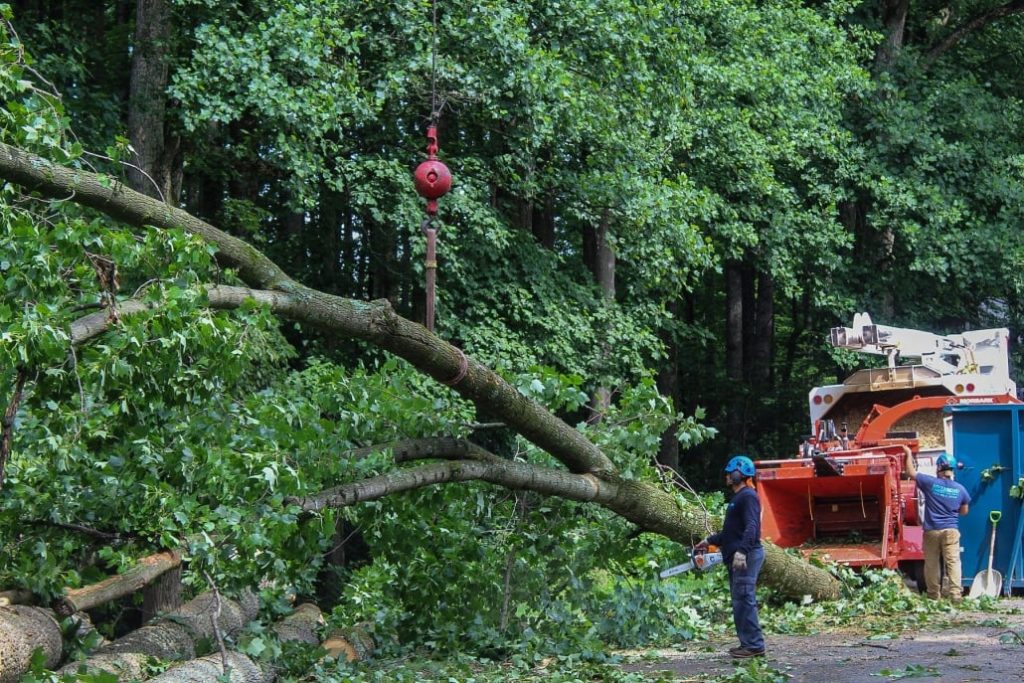Imagine yourself in a green backyard hideaway, where towering palm trees gently billow in the wind. There may come a time when you have to say goodbye to one of these majestic huge companies, even though they add a touch of the tropics to your environment. Whether it’s for safety reasons, space constraints, or simply a change of scenery, cutting down a palm tree requires expertise and careful consideration. In this post, we’ll walk you through the safe and effective removal of a palm tree step-by-step.
Understanding to Cut Down a Palm Tree
Understanding the structure of a palm tree is important before starting the cutting process. These trees are unique because they have a central stem, fronds, and a root ball. Knowing these components will enable you to organize your cutting technique and guarantee a seamless removal.
Examining the Circumstances for the Cutting of Palm Tree
Look first at the area around the tree. Are there any nearby structures, power lines, or trees that the removal would affect? Prioritizing safety should always come first. If the palm tree is close to any obstacles, you may want to consider seeking professional help or use advanced rigging techniques to manipulate the fall’s trajectory.
Assemble the Appropriate Tools and Supplies
Verify that the tools you are using are appropriate for the job. The tools you’ll need are a strong ladder, safety glasses, gloves, and a sharp-bladed chainsaw. Furthermore, having a friend or family member serve as a spotter during cutting might add an additional degree of protection.
Deciding the Right Time to Cut Down Palm Tree
When it comes to taking down a palm tree, timing is crucial. A day that is dry and has little to no wind is ideal. Weather that is windy or wet may make things more difficult and dangerous. Before doing any task, make sure to check the local weather forecast.
Detailed Procedure to Cut down a Palm Tree
First, the Fronds: First, prune the fronds from the tree’s lowest branches. To properly cut these smaller branches off, you can use a pole saw or a handsaw. By reducing the weight, this phase facilitates greater control over the cutting process.
Identify the Direction of the Fall: Find out how lanky the palm tree is naturally. This is how you want the tree to fall. Clear the landscape in that direction to ensure a safe landing area.
Make a Horizontal Cut: Using the chainsaw, cut a horizontal opening in the trunk about one-third of the way through. This incision, often called a notch cut, should have its side towards the direction in which the fall is desired.
Make a Wedge Cut: To create a notch, make a wedge cut below the notch cut. To direct the tree’s fall, this incision should be performed at a downward angle. The horizontal cut and the wedge cut should meet at the same depth.
Finish the Final Cut: Make the last straight cut on the other side of the tree, just above the bottom of the notch cut. This incision has allowed the tree to fall in the intended direction.
After making the last cut, retreat to a safe distance by using the autumn path that has been marked. The palm tree must descend in the desired direction gently and steadily.
Taking Care of the Palm Tree after Cutting
When you have successfully taken down the palm tree, you will be left with a stump. Depending on your tastes and your long-term objectives for the region, you may choose to grind down the stump, remove it entirely, or leave it in situ. For stump removal, it might be essential to carry extra instruments or employ an expert.
Safety Tips and Measures
Put on protective gear Make sure you are using the appropriate protective gear, such as gloves, goggles, and strong boots, to protect yourself during the cutting process.
Using a Sharp Chainsaw at Work: A well-tuned chainsaw reduces the chance of accidents and increases cutting efficiency. Regularly inspect and sharpen the chainsaw blade as needed.
Have a Spotter: As you cut, try to find a helper to serve as your spotter. They are able to alert you to any potential threats and provide assistance as needed.
Observe Local Laws: Know whether any permissions or municipal laws apply to the removal of trees. Certain tree species removal may be subject to special regulations in some places.
Think About Hiring a Professional: If the palm tree is tall and in a precarious place,or puts adjacent structures at risk, getting expert assistance is a smart move.
FAQs
I want to take down a palm tree in my backyard, is it legal?
Verify local laws and secure the required permits before taking down a palm tree. There may be variations in the laws governing tree removal, so be sure you follow the rules in your region.
I want to chop down a palm tree; can I use any chainsaw for that?
Although a palm tree can theoretically be chopped down with any chainsaw, it’s best to use one designed for cutting down trees. To guarantee a safe and efficient cutting procedure, choose a model with enough power and safety features.
What season is ideal for cutting down palm trees?
A palm tree should ideally be taken down in its dormant season, which is late autumn or early winter. The tree is under less stress during this time, which makes the removal procedure easier to handle.
Are there any particular safety measures I need to follow before cutting?
Absolutely, put safety first by donning the proper clothing, such as steel-toed boots, gloves, a helmet, and earplugs. To reduce dangers, remove any obstructions from the work area and arrange the path of the tree’s fall.
What should I do if there are illnesses or pest infestations in my palm tree?
Treat illnesses and pest infestations prior to chopping down the palm tree. To decide on the best course of action, consult a qualified arborist. Removing a sick tree might require additional precautions.
Conclusion
Cutting down a palm tree requires careful planning, knowledge, and attention to safety procedures. A palm tree may be successfully removed from your landscape if you understand its anatomy, assess the situation, and use a methodical cutting approach.
Always prioritize safety, use the right tools, and, if needed, seek professional assistance. You may bid your palm tree farewell and ensure a safe and orderly removal process by following the right procedures.





